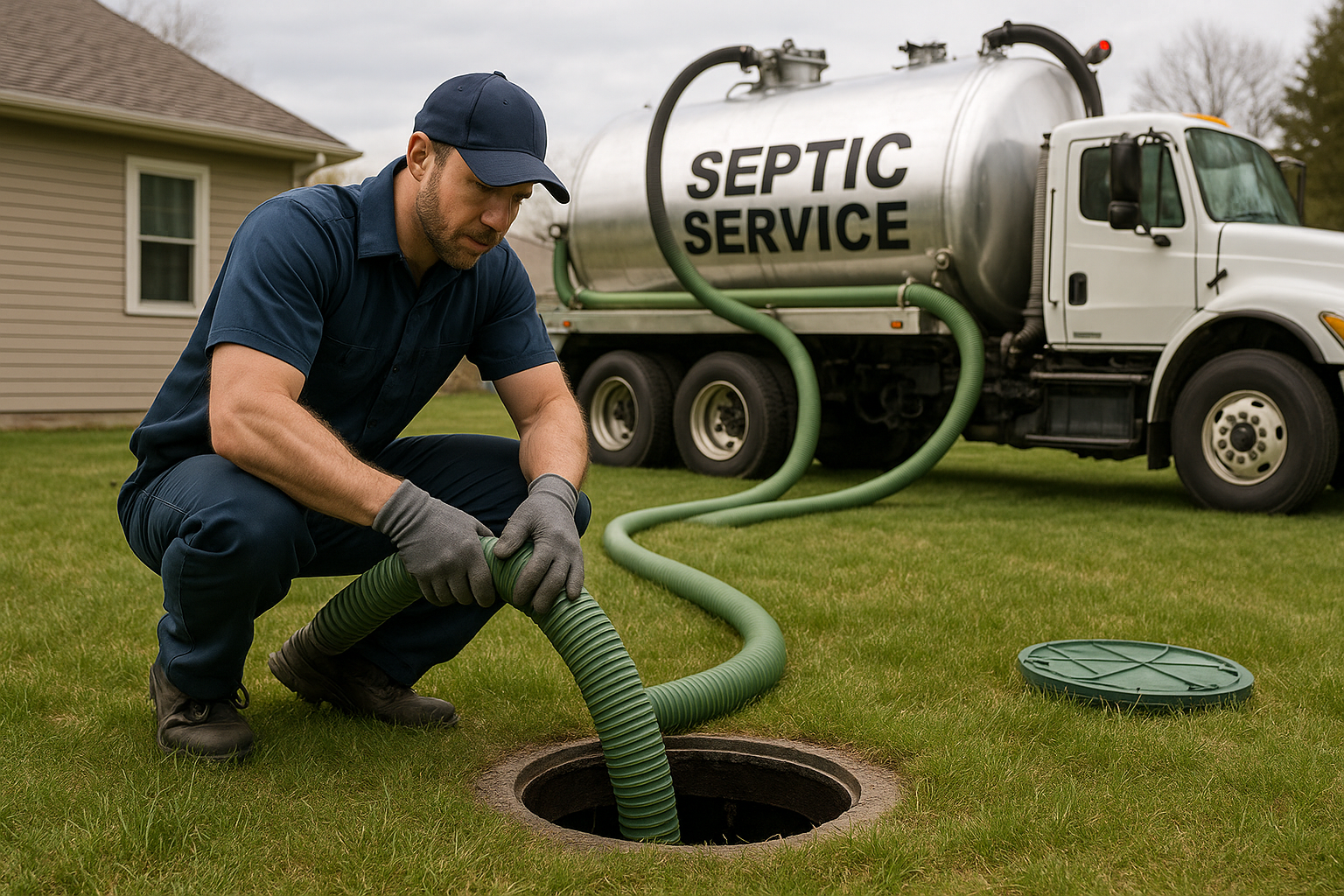When your septic tank starts overflowing, every second counts. What begins as a minor inconvenience—like slow drains or a faint odor—can quickly spiral into a full-blown septic system emergency. The result? Health risks, property damage, and expensive repairs that no homeowner wants to face.
A septic emergency doesn’t give much warning, and when it hits, it can feel overwhelming. But knowing what steps to take, who to call, and how to prevent future issues can make all the difference. In this guide, we’ll walk you through what to do during a septic tank emergency, how to spot early warning signs, and why routine maintenance is your best defense.
If you’d like to understand how routine cleaning and upkeep can help you avoid such emergencies altogether, explore our guide on Septic Tank Cleaning and Maintenance Tips.
Recognizing a Septic System Emergency
Your septic system quietly works beneath the surface, managing household waste day after day. But when things go wrong, the warning signs are often clear—if you know what to look for. Acting at the first sign of trouble can save your property, prevent contamination, and spare you thousands in unexpected costs.
Here are some of the most common red flags that point to a potential septic emergency:
- Slow-draining sinks and toilets – This is often the earliest sign that your septic tank is near capacity. Learn more about the process in our guide on Septic Tank Pump-Out Explained.
- Gurgling or bubbling drains – Air pockets in your pipes often indicate a clogged septic line or a backup forming inside the tank.
- Persistent foul odors – Unpleasant smells coming from your drains or yard can mean waste is leaking or your septic system is overflowing.
- Pooling water or soggy ground near the drain field – This could indicate that your drain field is failing or saturated, preventing wastewater from dispersing properly.
- Visible sewage backup – If sewage is backing up into your sinks, tubs, or toilets, you need emergency waste removal right away.
Catching these early can prevent a full-blown crisis. Homeowners who understand the Septic Tank Regulations and Homeowner Compliance are often better prepared to recognize and address problems before they escalate.
Immediate Actions Before Help Arrives
If your septic system starts acting up, quick action is key. While waiting for a professional emergency septic tank service, there are important steps you can take to protect your home and health. These actions won’t permanently solve the issue—but they can help prevent the situation from getting worse.
Here’s what to do immediately:
- Stop using water – Turn off faucets, showers, dishwashers, and laundry machines. Every drop adds pressure to an already overwhelmed tank.
- Avoid flushing toilets – Each flush pushes more wastewater into a system that can’t handle it.
- Turn off electrical systems near affected areas – If water has spread near outlets or electrical panels, avoid contact to reduce risk of shock.
- Mark off flooded areas – Keep kids and pets away from contaminated zones, as bacteria and pathogens in sewage can cause illness.
- Call for professional help – Search for “emergency septic service near me” or “24/7 septic pumping” to find a qualified local provider who offers same-day service.
When the emergency plumber septic team arrives, they’ll typically begin with an emergency septic tank pump-out. This involves using high-powered vacuum trucks to remove the waste quickly and safely. Afterward, they’ll inspect your tank and system components to pinpoint the cause—whether it’s a blockage, a drain field issue, or a septic pump malfunction.
Taking these steps can help you contain the problem until experts take over. Staying calm, acting fast, and preventing further contamination is the best way to minimize repair costs and damage.
When to Call a Professional Septic Service
Many homeowners try to wait out septic issues, hoping the problem will resolve itself. Unfortunately, septic system problems never disappear without professional intervention—and waiting can make things far worse.
If you notice sewage backup, foul odors, or slow drainage across multiple fixtures, it’s time to contact a septic emergency service immediately. Professionals have the expertise, equipment, and safety gear to resolve the issue efficiently and safely.
Here are key signs it’s time to call for professional help:
- Sewage backing up indoors – Even a small backup indicates that your system is at capacity.
- Standing water near the tank or drain field – This could point to septic overflow or a failing leach field.
- System alarms or warning lights – Many modern systems include sensors that alert you to high water levels or pump failure.
- Strong, persistent odors – This could suggest a cracked tank, a blocked vent, or system overload.
A professional local septic company can perform same-day septic pump-outs, diagnose your system, and perform emergency waste system repairs if needed. Most providers offer after-hours septic service to prevent damage from spreading overnight.
Concerned about costs? Understanding your options ahead of time can help you plan. Check out our Septic Tank Pump-Out Cost Guide for 2025 for insights into pricing, service types, and what to expect.
Hiring a licensed septic technician isn’t just about fixing the issue—it’s about protecting your property, preventing environmental contamination, and ensuring long-term system health.
Preventing Future Septic Emergencies
Once your immediate crisis is resolved, the next step is prevention. Regular septic care helps you avoid future emergencies and prolongs your system’s lifespan.
Here are proven steps to maintain a healthy system and prevent costly breakdowns:
- Schedule routine pumping and inspections – Have your septic tank serviced every three to five years. For detailed guidance, see our article on How Often Should You Pump Out Your Septic Tank.
- Monitor water usage – Large amounts of water entering the tank in a short period can cause overflow or backups. Spread laundry and dishwashing throughout the week.
- Be mindful of what you flush – Avoid sending non-biodegradable items like wipes, paper towels, or feminine products down the drain.
- Use septic-safe cleaners – Harsh chemicals can disrupt the natural bacterial balance inside your tank, reducing its efficiency.
- Maintain your drain field – Keep heavy machinery and vehicles off your drain field to prevent soil compaction, which restricts wastewater absorption.
A maintenance log helps track septic tank pumping costs, inspection dates, and repair history. By staying proactive, you can prevent minor issues from turning into emergencies and save money in the long run.
If you’re interested in learning more about septic system efficiency and safe operation, visit our comprehensive guide on Septic Tank Cleaning and Maintenance Tips.
The Hidden Costs of Delay
Ignoring septic warning signs can be one of the most expensive mistakes a homeowner makes. What starts as a clogged line or minor odor could end up costing thousands in property repairs and restoration.
When sewage backs up, it doesn’t just damage flooring and drywall—it also exposes your home to harmful bacteria and unpleasant odors. Additionally, untreated leaks can contaminate groundwater, leading to health code violations and environmental damage.
The cost of emergency septic pumping is small compared to the price of neglect. A routine pump-out or inspection can prevent extensive damage and keep your property safe. Regular maintenance isn’t just about keeping your system functional—it’s an investment in your home’s long-term value and your family’s health.
By staying ahead of problems, homeowners can avoid paying premium fees for after-hours septic service or costly sewage backup cleanup.
How Technology Is Changing Septic System Care
Modern technology is transforming how homeowners manage their septic systems. From digital sensors to automated alerts, these advancements help prevent emergencies before they start.
Some of the latest innovations include:
- Smart monitoring systems – Sensors installed inside the tank can track sludge levels, alerting you before overflow occurs.
- Eco-friendly treatments – Biodegradable additives and advanced filtration systems improve wastewater breakdown and reduce system strain.
- Predictive maintenance apps – These tools help homeowners log pumping schedules and receive reminders for inspections.
- Real-time diagnostic tools – Many service providers now use camera inspections and digital mapping to detect issues early.
These technologies don’t replace professional service but complement it by helping you make informed decisions. Homeowners who adopt these tools often experience fewer residential septic emergencies and lower maintenance costs over time.
Final Thoughts
When your septic system fails, quick action can mean the difference between a manageable issue and a major disaster. Recognizing early warning signs, taking immediate precautions, and calling a 24-hour septic service can protect your home from contamination and costly repairs.
However, prevention remains the most powerful solution. By scheduling routine septic maintenance, keeping track of your pumping frequency, and understanding your local septic regulations, you can reduce your risk of ever facing an emergency.
If you’d like to learn more about how to care for your septic system effectively, visit our Septic Tank Cleaning and Maintenance Tips and Septic Tank Pump-Out Frequency Guide.
By staying proactive, informed, and ready to act fast, you’ll not only protect your property but also ensure a cleaner, safer living environment for your family.






